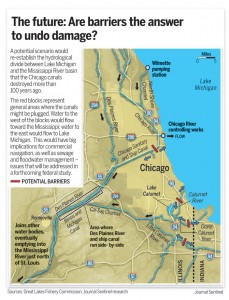On Thursday, Oct. 13th, I took some time away from my normal professorial duties to attend a lunchtime forum entitled “Chicago’s Water: Protecting Our Precious Resource,” sponsored by the Chicago Council on Science and Technology. The event was held in the 18th floor “Wolf Point Ballroom” in the Holiday Inn Chicago Mart Plaza, literally right off that parking lot that sits on Wolf Point. Floor to ceiling views of the Chicago River and the skyline made for a dramatic setting for the event and the ensuing conversation about the history and future of water management in Chicago.

I couldn’t help but notice the remarkably clear view of the Combined Sewage Outfall (CSO) location where my students and I rafted up our canoes the previous weekend in the Loop and discussed the impact of stormwater overflows of untreated wastewater on the ecology of the Chicago River. It was both odd and inspiring to view that location from up high, only a few days later.
This exceptionally interesting forum featured a keynote address by Debra Shore, an Metropolitan Water Reclamation District commissioner who, unlike most commissioners past and present, actually has a long track record in environmental conservation and advocacy. She is one of the drivers of the recent turnaround in MWRD policy with respect to the disinfection of wastwater. Shore’s presentation highlighted the history of Chicago’s development and its relation to the river, the technological changes that have been wrought upon the latter, the key issues facing us in the 21st century (water quality, Asian Carp, hydrological separation, etc.), and a broad question at the end: “Can Chicago become Nature’s Metropolis for the 21st Century?” In the latter, she implied that how we manage the river will be a large part of the answer to that question.
Shore’s keynote was followed by an immensely interesting panel discussion moderated by Howard Learner, an attorney who runs the Environmental Law and Policy Center (a local environmental think-tank and non-profit). The panelists included Tinka Hyde, acting director of the USEPA Region 5’s water division; Andrew Richardson, an wastewater engineer and CEO of Greeley and Hanson; and Martin Felsen, a principal architect at the UrbanLab design firm and professor at IIT who specializes in the design of green infrastructure in urban environments.
One key theme that repeatedly came up during the forum’s dialogue was the notion of separating the watersheds as a way to improve water conservation and prevent invasive species (notably the carp) from entering the GLs. Surprisingly, none of the engineers on the panel or in the audience claimed that such a separation was technically impossible, or even too costly to attempt. What they repeatedly cited was the need for the political will and creation of effective avenues of communication and collaboration to do it. If that happened, then the technology could be brought to bear productively. This view was even espoused by Dick Lanyon, the longtime engineer for and then manager of the MWRD who retired in 2010 and who was at this meeting (coincidentally, I sat next to him and got to bend his ear for several minutes after the program). Lanyon is a key source about water management in the Chicago region in Peter Annin’s 2006 book, The Great Lakes Water Wars .
Another issue that was discussed was the status of the current studies underway to assess the feasibility and impacts of hydrological separation. The Army Corps of Engineers’ study was cited several times, favorably, despite it’s rather slow projected timeline that has raised the pique of neighboring Great Lakes states; and Tinka Hyde, the EPA rep, noted that USEPA was collaborating with the Corps on this process.

No mention of the long timeline was made. Neither was the parallel and comparatively fast-track study by the Michigan-based Great Lakes Commission even mentioned. I was going to ask a question about this in the Q-and-A period, but the panel ran out of time since there was so much discussion after the formal presentations.
Those interested in following up on the status of the GLC’s planning process, as well as learning more about the environmental and ecological prospects of hydrologically separating the Great Lakes and Mississippi River watersheds can read more about it here and/or attend a public webinar on Oct. 24th for the GLC’s Chicago Area Waterway Study.
2 thoughts on “Watersheds, Carp, and the Future of Chicago’s Water”
Comments are closed.